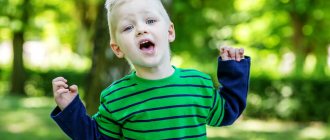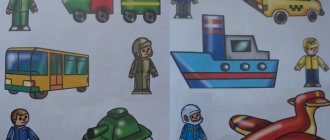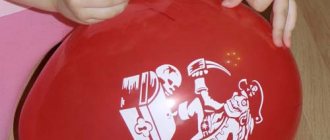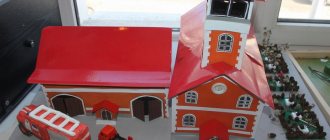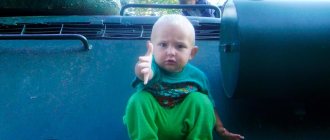“You need shoes that are breathable, made of genuine leather - for outdoor use; in a group you can wear slippers, but sandals are better. For the first time, bring a large supply of clothes, simple, inexpensive, kids in nurseries very often get them dirty, we change them ten times a day, especially after drawing or eating,” a teacher at a private kindergarten in one of the residential areas of Moscow tells me.
My baby is about to go to kindergarten, I, like all mothers, am afraid that he will go hungry, offended or unloved. Adaptation, of course, has not been canceled, but even the simplest things can make separation from the mother less tragic for the child. So, how to prepare for your first trip to kindergarten? This article will be a useful guide for myself, so let’s start with the main thing.
T-shirts, shorts, and what else?
Each kindergarten has its own list of necessary clothes that parents must prepare for being in the group, sleeping and walking. But in general, the lists are very similar, the main rule is: the younger the child, the more spare sets should be stored in his locker.
What if the baby has not yet made friends with the potty? This question worried me very much, since we still have “accidents”. This is not a reason to refuse to attend kindergarten. It’s just that at first the baby will go with “insurance”, but not in the form of a diaper, but in the form of special waterproof panties. He will go potty with all the kids, but if he suddenly misses the moment, the carpet in the group will remain dry.
Clothes for being in a group:
- The biggest “stock” you should prepare is underwear. More panties, a little less T-shirts. You can easily determine the amount yourself, how much does it usually take you per day, how often do you have to change your baby’s clothes? The optimal quantity is at least three sets per day.
- Shorts and skirts in summer, pants and tights in winter. Please note that simple models that the child can put on himself are most suitable.
- T-shirt, T-shirt - in summer, blouse, sweater, turtleneck - in winter. Avoid one-piece overalls; it will be difficult for your baby to use the potty in them.
- Shoes: you will need at least two pairs for a daytime stay in the group; these are ordinary slippers with Velcro, sandals, ballet flats, shoes for girls. Any shoes - only with a back and straps. Czechs can come in handy for dance lessons, yes, even for boys.
- Socks, knee socks - at least three pairs per day, one regular, one spare, one warm - for a walk in the cool season.
- Often, children do not change clothes for naps; they simply remain in T-shirts and panties, but if you wish, you can bring cotton pajamas, especially if it is cool in the group.
Clothes for walking:
- Headgear - depending on the weather, one is enough, do not forget about a panama hat in the summer, and a shirtfront in the winter, it will protect your neck from the wind. Also stock up on at least two sets of mittens, preferably waterproof ones.
- In the warm season - trousers, leggings, jeans, a tracksuit, a knitted set - anything can be, the main thing is that the child does not overheat, but does not freeze.
- A jacket for a walk: it can be very simple and inexpensive, and most importantly not a brand name, so that you don’t have to wash it every day.
- Shoes: also depending on the weather, one seasonal pair of shoes is enough, as well as rubber boots in case of wet weather.
- There is no need for too warm sheepskin coats and felt boots; walks are canceled in cold weather.
A little trick that has become commonplace for experienced mothers, but may not yet be known to “newbies” is to bring your child to kindergarten in “decent” outerwear, and to have a spare jacket and pants ready for a walk. That is, the baby does not risk ruining a good “going out” set, but also does not scare passers-by with his appearance on the way home from the garden.
Clothes for classes and events
Also, a young kindergartener will need a set of festive clothes; you can buy them immediately before a significant date, for example, a themed carnival costume.
For sports activities, a separate set is required; it is not necessary to buy a tracksuit; you can get by with shorts with a T-shirt, or leggings with a T-shirt. But it’s better to buy shoes for sports; they should fix the ankle well and also have good shock absorption.
What should the clothes be like?
Simple, made from natural fabrics, without unnecessary decorative elements. Fastener: linden for shoes, elastic for pants, simple silhouette for blouses without zippers, lacing or buttons. Don't forget to label each item of clothing on the reverse side; you can use the free space on the tags for this.
One day in the life of children in kindergarten!
Today, parents are very often interested in the life of their child and the kindergarten as a whole, but you can’t tell about everything in 5 minutes in the reception room, because every day means a lot to the child!
Children live in the kindergarten, play and sing here, and find friends here. They go for walks with them. They argue and dream together, growing up imperceptibly. The kindergarten is their second home, how warm and cozy it is! You love it children, the kindest home in the world! I'll tell you a secret.
The morning begins with the traditional greeting ritual. We say hello, smile, share news, consult what we would like to do today, do morning exercises. Even though the children are small, they speak very well. The children suggested a topic about birds, I supported their initiative, we held a finger game “Magpie White-sided”. The children liked it so much that almost everyone ate the porridge at breakfast.
For the lesson we played the fairy tale “Ryaba Hen”, using natural materials (twigs, sticks, pine cones, logs), it turned out to be lively, active, and varied. After which they turned into birds and flew off to get dressed for a walk.
Outside in the “Bird Canteen,” the kids fed grain and seeds to the birds, which come to eat during the cold season, especially in winter. The children watched from the sidelines at the birds whose names they knew: tit, sparrow, bullfinch, what color their breasts were (yellow, red or brown), then we hung new feeders that the parents brought, made with their own hands together with the children, played played the active game “Tit Birds”, and having turned into birds, returned to the group in a good mood for lunch.
After lunch, the children, finding themselves in a warm, cozy crib, tired and happy, fell into a sound and healthy sleep. We woke up, stretched, smiled. We did gymnastics after a nap, walked along the “health path”, and rolled logs with our feet. In children, this helps to form the arches of the feet and prevent flat feet.
After having an afternoon snack, Eva asked me to draw a bird, everyone else joined her, and as a result, the children and I created a creative exhibition of birds for the parents in the reception room. Having finished, the children continued their free play activities. Now it’s time for dinner, after which parents begin to slowly take their children home.
Dear parents, do not forget to talk with your children, because kindergarten through the eyes of a child may look completely different. They can tell you a lot of interesting things. Another weekday garden day has come to an end.
Baby hygiene: what will be useful in kindergarten?
Each particular kindergarten may also ask you to bring various personal items for the child, including:
- Bibs for feeding, preferably plastic rather than cloth, two or three pieces are enough.
- A set of dishes for your baby, the simplest ones that you don’t mind breaking.
- To sleep, you may need your own set of bed linen, oilcloth, and replacement sheets.
- A girl should always have in her locker: a comb, hairpins, elastic bands, and hair bands.
- Their own towel for their hands, and in the summer also for their feet; after a walk, children will be taught to wash their feet from sand.
What is adaptation?
Imagine the world of a small child. Beloved mom and dad, familiar toys, a warm bed, familiar surroundings and daily routine.
And suddenly one day everything changes. His mother takes him to an unfamiliar place and leaves him with a strange aunt. Everything in this place is foreign - the toys, the crib, and the food are not the same as at home. And most importantly, there are a lot of unfamiliar children there, who often cry, and some may even offend. At this point you need to listen to the teacher and do everything she says. This place is called kindergarten...
⠀
Finding himself in an unfamiliar environment, the child is in a state of extreme stress. In order for him to get used to it, he must go through a period of adaptation. This term means the ability to adapt to environmental conditions, to adapt to them.
During adaptation, the activity of almost all systems of the child’s body undergoes a restructuring.
Adaptation of a child to the conditions of a kindergarten is usually accompanied by the following phenomena:
- regression of skills occurs (the child temporarily “forgets” how to go to the potty, hold a spoon, etc.);
- sleep and appetite worsen;
- the child looks depressed, lethargic, lethargic;
- frequent whims, hysterics for any reason.
There are 3 categories of children. For some, adaptation problems begin immediately, for others - after 2-3 weeks, for others there are no visible changes. This is due to many factors and depends on the adaptive capabilities of the child’s body.
You should not be afraid of changes in the behavior of your son or daughter. In this way, the child’s body copes with the stress and adapts to new conditions.
Degrees of adaptation
Designed by Freepik
There are mild, moderate and severe degrees of adaptation of a child to kindergarten.
Easy degree
A child with a mild degree adapts on average in 2-4 weeks. An easy degree of adaptation will be characterized by the following indicators:
- Sleep : the child sleeps peacefully during daytime and nighttime sleep, may sometimes wake up, but easily falls asleep again.
- Appetite : good, may be selective in dishes.
- Emotional state : even, calm.
- Behavior : without tears or hysterics, he lets go of his mother and remains in the group. Can keep himself busy playing.
- Communication with adults and peers: makes contact with teachers and children, can ask the teacher for help, gets involved in games with peers.
Even with a mild degree of adaptation, the child may initially experience sleep and appetite disturbances.
Average degree
The average degree of adaptation lasts more than a month. The child is often sick, and getting used to kindergarten is difficult due to long breaks.
Adaptation of moderate severity can be judged by the following criteria:
- Sleep: the child sometimes does not sleep during quiet hours; if he falls asleep, his sleep is restless and intermittent.
- Appetite: may refuse some dishes, eats little.
- Emotional state: often cries, is sad, mood changes for minor reasons. Can keep himself busy with the game, but for a short time.
- Behavior: has difficulty parting with his mother, and after she leaves he stands alone at the window for a long time.
- Communication with adults and peers: shows no interest in communication, constantly asks the teacher if mom will come soon.
A child with a severe degree of adaptation may take more than 2 months to get used to kindergarten, or may not get used to it at all. Then doctors recommend refusing to attend preschool.
Severe degree
Severe addiction is typical for children with disabilities.
The fact that it is not easy for a child to adapt to kindergarten can be judged by the following indicators:
- Sleep : the child does not sleep during quiet hours. At night, sleep is restless, intermittent, and there are night terrors.
- Appetite : decreased, may refuse to eat.
- Emotional state: depressed, the child seems to withdraw into himself or, on the contrary, is aggressive.
- Behavior: after mom leaves, she cries, screams, does not want to go into the group, and can sit in the locker room for a long time.
- Communication with adults and peers: does not make contact or shows aggression towards children and adults.
The completion of a child’s adaptation period can be judged by the stabilization of all indicators.
Make sure that your child's adaptation is going smoothly or check if he has any problems so that you can help in time. Use the “Where are my children” application in combination with a children's smart watch - instantly contact your child, listen to the sound around you and always know where he is.
Stages of addiction
The process of a child getting used to kindergarten takes place in several stages.
Stage 1 – period of maladjustment. No matter how the parents prepare the child for the nursery, at first he will still be in a state of stress and constant tension. It is difficult for a child to part with his parents; he often cries and is capricious. Colds may begin.
Stage 2 – adaptation period. The protective mechanisms of the psyche are triggered, the child begins to communicate with the teacher and other children, participates in games, but still misses his parents and often asks about them. At this stage, the baby is just beginning to get used to the new rules, so he may violate discipline and refuse to comply with the teacher’s demands.
Stage 3 – compensation period. The adaptation process is completed, the child gets used to the children's team, teachers and the new daily routine, and calmly lets his parents go for the whole day. The emotional background stabilizes, physiological indicators return to normal.
How long each stage will last depends on the individual characteristics of the baby.
FIND A TOY.
The leader hides a small toy in the group, in one of its rooms, and then invites the others to find it. At first it is not so difficult to find, for example:
“The toy is lying on the windowsill in the reception (locker room). Then more difficult:
“The toy lies in the bedroom, under the pillow on Nadya’s bed.”
After the toy is found, it must be said what it was doing there (going for a walk, sleeping...)
Later, you can guess the location of the toy in a different way: through the function of the room (“Washes the dishes”), through its actions (“Lies quietly, eyes closed”).
Having mastered the group, you can move on to a closer acquaintance with the kindergarten and its employees. It’s better to start with excursions around the garden (it’s more advisable to organize thematic excursions: to the kitchen, to the medical office), and get to know the people working there.
HOW TO GET?
Goal: to help children navigate in kindergarten, to correctly find this or that room.
Approximate scheme of the game.
The teacher says that the bunny Stepashka’s ears hurt. What should he do? Go to the doctor
. But Stepashka doesn’t know where the medical office is, we need to help him. Three or four children are asked to “accompany” Stepashka to the doctor (medical workers are warned about the upcoming visit in advance). The teacher comments all the way to the office (first we will leave the group, then we will go down the stairs, then we will walk along the corridor and reach the medical office) and back. You can be guided by some objective signs: let’s go down the stairs and immediately after the drawn bunny will roll up. The cured Stepashka thanks the children for their help and conveys the doctor’s wishes not to get sick and vitamins for all the children. In much the same way, you can “wash” a dress for a Katya doll, or borrow an interesting book or game from a methodologist.
